Burkina Faso |
|
|
|
| Übersicht – Contents: | |
Diese Seite ist Teil des Projektes
Burkina Faso |
|
|
|
| Übersicht – Contents: | |
Flaggen – Flags: |
|
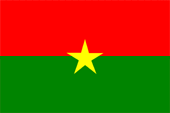 |
Nationalflagge – national flag, |
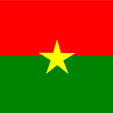 |
Flagge des Präsidenten |
historische Flaggen – historical Flags: |
|
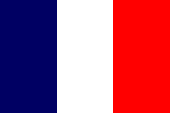 |
1895–1959, |
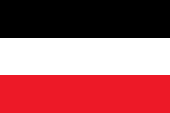 |
1959–1984, |
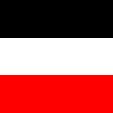 |
1959–1984, |
Bedeutung/Ursprung der Flagge – Meaning/Origin of the Flag: |
|
| Die Flagge von Obervolta wurde am 09.12.1959 eingeführt, und für das unabhängige Obervolta übernommen. Sie zeigte drei horizontale Streifen in Schwarz, Weiß und Rot. Die drei Farben standen für die drei Arme des Flusses Volta (Roter Volta, Weißer Volta und Schwarzer Volta). Nach dem Sankara-Putsch (04.08.1983) wurde Obervolta genau ein Jahr später in Burkina Faso umbenannt, und die bisherige Flagge als angeblich neokolonialistisches Symbol abgeschafft. Die neue Flagge wurde also am 04.08.1984 eingeführt. Sie zeigt die panafrikanischen Farben, zwei waagerechte Streifen in Rot und Grün mit einem gelben Stern in der Mitte. Der Stern soll den revolutionären Charakter der neuen Machthaber versinnbildlichen. Grün steht für die Fruchtbarkeit des Landes, und Rot für das im Unabhängigkeitskampf vergossene Blut. Die Farbkombination von Grün, Gelb und Rot sind die panafrikanischen Farben: Etwa 1900 setzte die Panafrika-Bewegung ein, die Gemeinsamkeiten aller Menschen mit schwarzer Hautfarbe hervorheben wollte. Für die politische Einheit Afrikas steht der Farbendreiklang Grün-Gelb-Rot, den viele afrikanische Staaten nach Erlangung ihrer Unabhängigkeit in ihre Flaggen übernahmen. Das erste Land war Ghana im Jahr 1957. Als Ursprung gelten die Landesfarben von Athiopien (Abessinien), dem ältesten unabhängigen Staat Afrikas. | The flag of Upper Volta
was introduced on the 9th of December in 1959, and undertoken for the independent Upper
Volta. It showed three horizontal stripes in black, white and red. The three colors stood
for the three arms of the river Volta (Red Volta, White Volta and Black Volta). After the Sankara-revolt (4th of August in 1983) Upper Volta was renamed in Burkina Faso exactly one year later, and the hitherto valid flag abolished as an alleged neo-colonialist symbol. The new flag was so introduced on the 4th of August in 1984. It shows the pan-african colors, two horizontal stripes in red and green with a yellow star in the middle. The star should symbolize the revolutionar character of the new rulers. Green stands for the fertility of the land, and red for the in the fight of independence shed blood. The combination of the colours green, yellow and red are the pan-african colours: Perhaps in 1900 was the beginning of the Panafrica-Movement, wich wants to emphasize the commons of all people with black skin. For the political unity of Africa stands the colour-triad green-yellow-red, wich used many african countries in their flags after the independence. The first country was Ghana in 1957. As the origin apply the colours of Ethiopia (Abessinia), the oldest independent state in Africa. |
| Quelle/Source: Die Welt der Flaggen | |
Wappen – Coat of Arms: |
|
 |
seit/since 1997, Wappen von Burkina Faso – coat of arms of Burkina Faso, Quelle/Source nach/by: Wikipedia (D) |
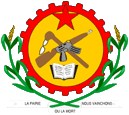 |
1984–1997, Wappen von Burkina Faso – coat of arms of Burkina Faso, Quelle/Source: Corel Draw 4, Wikipedia (D) |
 |
1958-1984, Wappen von Obervolta – coat of arms of Upper Volta, Quelle/Source nach/by: Wikipedia (FR) |
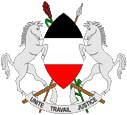 |
Wappen von Obervolta – coat of arms of Upper Volta, unbekannte Version – unknown version |
Bedeutung/Ursprung des Wappens – Meaning/Origin of the Coat of Arms: |
|
| Am 04.05.1961 wurde offiziell das Staatswappen der ehemaligen autonomen Republik von 1958 übernommen. Es bestand aus einem blauen Schild, darauf in der Mitte ein kleinerer Schild (Herzschild) in den Landesfarben, mit den goldenen Initialen des Landes darauf (RHV – République de Haute-Volta). Links und rechts des Herzschildes je ein weißes Pferd als Schildhalter, darunter Sorghopflanzen und zwei Hacken. Hinter dem Herzschild zwei gekreuzte Speere, und darüber das Staatsmotto in einem Spruchband: "Unité, Travail, Justice" => "Einigkeit, Arbeit, Gerechtigkeit". | On
4th of May in 1961 the national coat of arms of the former autonomous republic from 1958
was officially adopted. It contained in a blue shield, thereupon in the middle a smaller shield (heart shield) in the colors of the country, with the golden initials of the land thereupon (RHV – République de Haute-Volta). To the left and on the right of the heart shield ever one white horse as shield holder, underneath sorgho plants and two hoes. Behind the heart shield two crossed spears, and above that the motto of the state in a motto ribbon: "Unité, Travail, Justice" => "unity, work, justice". |
| In Folge des Sankara-Putsches (04.08.1983) wurde ein Jahr später nicht nur das Land umbenannt und eine neue Flagge eingeführt, sondern auch ein neues, marxistisches Wappen angenommen. Es zeigte ein rotes Zahnrad mit gelbem Hintergrund, darin eine Hacke gekreuzt mit einer Maschinenpistole (Kalaschnikow), ein aufgeschlagenes Buch und oben einen roter Stern. Links und rechts war das Zahnrad von Sorghopflanzen umgeben, darunter ein Spruchband mit dem neuen Landesmotto: "La Patrie ou la Mort, nous vaincrons" => "Vaterland oder Tod, wir siegen". | In consequence of the
Sankara-coup (4th of August in 1983) one year later not only the country was renamed and
introduced a new flag, but it was also adopted a new marxist coat of arms.
It showed a red gear with a yellow background, in it a hoe crossed with a machine gun (Kalashnikov), an opened book and above a red star. Left and right the coat of arms was surrounded by sorghum plants; below a banner with the new national motto: "La Patrie ou la Mort, nous vaincrons" => "fatherland or death, we win. " |
| Im Jahre 1997 wurde ein
neues, bürgerliches Wappen eingeführt, das an die Traditionen des ersten Wappens von
Obervolta anknüpft: Die Sorgho-Pflanzen erscheinen nun ganz links und rechts außen, unter dem Herzschild mit dem Motiv der Flagge einscheint ein aufgeschlagenes Buch. Zwei Speere kreuzen sich hinter dem Schild. Hacken tauchen im Wappen nicht mehr auf. Das Spruchband über dem Herzschild trägt den Landesnamen in einer ungewöhnlichen Schreibweise: "Burchina Faso". Unter dem Schild ein Spruchband mit dem neuen Staatsmotto: "Unité, Progress, Justice" => "Einigkeit, Fortschritt, Gerechtigkeit". |
In 1997 was introduced
a new, civic coat of arms, which remebers the traditions of the first coat of arms
of Upper Volta: The sorghum plants now appear far left and far right, below the heartshield with the motive of the flag appeares an opened book. Two spears cross behind the shield. Hoes appear in the coat of arms no longer. The banner over the central shield carrys the name of the country in an unusual style: "Burchina Faso". Below the shield a banner with the new state motto: "Unité, Progress, Justice" => "Unity, Progress, Justice". |
| Quelle/Source: Flaggen und Wappen der Welt, Wikipedia (D) | |
Flugzeugkokarde – aircraft roundel: |
|
 |
bis/to 1984, Flugzeugkokarde – aircraft roundel Quelle/Source: nach/by Wikipedia (EN) |
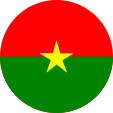 |
seit/since 1984, Flugzeugkokarde – aircraft roundel Quelle/Source: nach/by Wikipedia (EN) |
| Landkarten – Maps: |
Lage – Position: |
Landkarte des Landes – Map of the Country: |
Zahlen und Fakten – Numbers and Facts: |
|
|
|
|
|
|
|
|
|
|
|
|
|
|
|
|
|
|
|
Geschichte: |
|
1450–1896 · Mossi-Staat 1896 · Eroberung durch Frankreich 1919 · Gründung der Kolonie Obervolta 1958 · Autonome Republik Obervolta 05.08.1960 · Frankreich gewährt Unabhängigkeit 04.01.1966 · Lamizana-Putsch 04.08.1983 · Sankara-Putsch 04.08.1984 · Umbenennung in Burkina Faso 1987 · Compaoré-Putsch 1991 · neue Verfassung, Compaoré wird Präsident |
History: |
|
1450–1896 · Mossi State 1896 · conquest by France 1919 · establishment of the Upper Volta colony 1958 · Autonomous Republic of Upper Volta 5th of August in 1960 · France grants independence 4th of January in 1966 · Lamizana-revolt 4th of August in 1983 · Sankara-revolt 4th of August in 1984 · renamed in Burkina Faso 1987 · Compaoré-revolt 1991 · new constitution, Compaoré becomes president |
| Quelle/Source: Atlas zur Geschichte, Wikipedia (D), World Statesmen |
Ursprung des Landesnamens – Origin of the Country's Name: |
|
| Der Name "Obervolta" wurde dem Land von der Kolonialmacht Frankreich gegeben (Haute Volta). Er zeigt an, dass das Land an den Oberläufen des Flusses Volta liegt. Der Name Volta geht auf die Portugiesen zurück. Er heißt übersetzt "Kehre", "Kurve" oder auch "Krümmung", und hat seinen Ursprung in den zahlreichen Windungen des Flusses. | The name "Upper
Volta" was given to the land of the colonial power France (Haute Volta), It indicates
that the country is located on the upper reaches of the River Volta. The name Volta goes back to the Portuguese. It means translated "Return", "curve" or "curvature", and has its origin in the many windings of the river. |
| Der Name "Burkina Faso" ist zweisprachig. "Burkina" heißt in der Mòoré-Sprache "ehrenwerte Person“, "Faso" heißt in der Dioula-Sprache "Vaterhaus", womit "Vaterland“ gemeint ist. Der Landesnamen lautet also übersetzt: "Vaterland der Ehrenwerten". Es gibt allerdings auch andere übersetzungen: "Land der ehrenwerten Menschen“, "Land der Aufrichtigen“, "Land der Unbestechlichen“, "Land der Menschen mit erhobenem Kopf“. Es gibt auch unterschiedliche Schreibweisen: so z.B. "Burkina Fasso", im Wappen lautet der Landesname "Burchina Faso". | The name "Upper
Volta" is bilingual. "Burkina" means in the Mòoré language
"honorable person", "Faso" means in the Dioula language,
"father's house" what means "fatherland". The country's name is
translated: "Homeland of the Honourable". However, there are other translations: "Land of honorable
People", "Land of the Upright", "Land of the Incorruptible",
"Land of People with head up". There are also different spellings: eg
"Burkina Fasso", in the coat of arms is the country name "Burchina
Faso". |
| Quelle/Source: Wikipedia (D), Handbuch der geographischen Namen, Volker Preuss | |